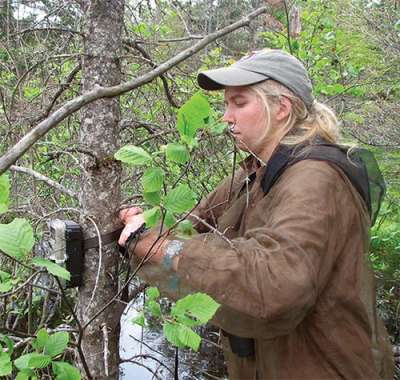
Rusty blackbird populations have declined by about 95 percent in the last 50 years, making their decline the fastest of any songbird in all of North America. They breed in stunted conifers deep in the wetlands of boreal forest and winter in the Southeast. Distinguished from other northeastern blackbirds by their bright yellow eyes and rust-colored feather edges, they are sometimes seen in mixed flocks with common grackles and red-winged blackbirds.
To learn why rusty blackbird populations have declined so rapidly, researchers from the SUNY College of Environmental Science and Forestry spent two years studying the bird’s breeding habitat in managed forests in Maine and New Hampshire. They uncovered a web of interactions between timber harvesting practices, spruce and fir cones, red squirrels, and rusty blackbird nests.
Graduate student and lead scientist Shannon Buckley Luepold said previous studies indicated that red squirrels were the primary predators on rusty blackbird nests and that nests in regenerating clear-cuts may be more vulnerable to squirrel predation than nests in undisturbed wetlands. So she used cameras at 29 blackbird nests to identify predators and collected data on vegetation density, spruce and fir cone production, and red squirrel abundance.
Luepold found that all of the squirrel predation in her two-year study came in a year that followed an abundant cone crop. “What this suggests is that rusty blackbirds experience higher levels of nest predation by red squirrels in the year following a mast year, and that this predation can significantly reduce their reproductive success in those years,” she said. “However, this is an ecological relationship that has likely existed for thousands of years, and is, therefore, not the driving force behind the decline. Rather, this annual variability in reproductive output could make it more difficult for the species to recover their numbers following a population decline, whatever caused the initial decline.”
Luepold found that dense vegetation was another important predictor of nest survival, so harvest practices that reduce the density of young trees, such as pre-commercial thinning, could potentially be detrimental to the birds. Luepold recommends that wildlife managers working on rusty blackbird breeding grounds seek to maintain areas of young, dense softwood stands near wetlands to provide high quality nesting habitat.
On the other hand, she believes the efforts to increase rusty blackbird numbers will also need to focus on their wintering grounds, where habitat loss is a greater threat to the birds than predators and habitat quality on their breeding grounds. She said that 75-80 percent of the wooded wetland habitat where they winter in the Southeast has been converted to agriculture, and additional preferred habitat has been lost due to urbanization, which is much greater than the scale of habitat loss on their breeding grounds in northern New England and Canada.
“I think our project highlights how the effects of timber harvesting and other anthropogenic activities on other species are often more complex and nuanced than one might first imagine,” said Luepold. “So much depends on the surrounding ecological context, and it often doesn’t easily reduce to a simple good or bad, black or white sort of scenario.”

